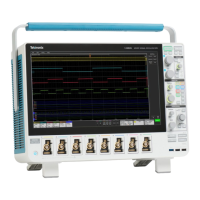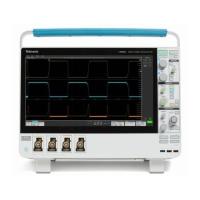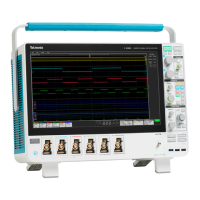Behavior. The correct termination is set automatically when you attach a probe with a TekProbe/TekVPI interface to the
instrument. However, you may have to set the termination manually if you use a probe without a TekProbe Interface.
Consider the following when using 50 Ω termination with any channel:
■
AC coupling is not available with 50 Ω termination.
■
The instrument reduces the maximum vertical scale setting for the channel with a X10 probe attached, since the amplitudes
appropriate for the higher settings would overload the 50 Ω input.
■
The instrument switches to 50 Ω and disables AC coupling (and switches coupling to DC if AC is selected) if you connect an
active probe. The active probes also reduce the maximum vertical scale setting as described above. This behavior results in
50 Ω, nonalternating current coupling, which is appropriate for active probes.
What do you want to do next?
Continue to learn about the Vertical Setup controls.
Return to the Vertical Setup control window overview.
Low impedance probes
Most low impedance (Z
o
) passive probes measure frequencies or timing measurements more accurately than general-purpose
probes, but they take less accurate amplitude measurements. They offer a higher bandwidth to cost ratio.
The low input impedance passive probes must be terminated in a 50 Ω instrument input. Input capacitance is much lower than
high impedance passive probes, typically 1 pF, but input resistance is also lower (500 Ω to 5000 Ω typically). Although that DC
loading degrades amplitude accuracy, the lower input capacitance reduces high frequency loading to the circuit under test. That
makes low input impedance passive probes ideal for timing and phase measurements when amplitude accuracy is not a major
concern. Low input passive impedance probes are useful for measurements up to 40 V.
Set the termination voltage
Termination Voltage is available only on MSO/DPO70000DX/SX Series instruments.
From the Vertical menu, select Vertical Setup.
To use. Use the Termination Voltage control to set the channel termination voltage:
■
Click Termination Voltage.
■
Set the termination voltage using the keypad or multipurpose knobs.
Behavior. Oscilloscope inputs have traditionally been terminated to ground. The signals being measured often are not ground
referenced. Pulling signals to ground can impair measurement results or potentially damage the DUT.
The instrument delivers variable termination voltage up to ±3.5 Volts to the device under test (DUT), and supports a large offset
range.
This allows you to adjust the oscilloscope to mirror the conditions and behavior of the DUT, and measure high-speed signals in
an environment similar to the one in which they operate.
Using the combination of termination voltage and offset to center the oscilloscope reference point in the operating range of the
DUT maximizes the available dynamic range and minimizes the noise of the measurement system.
What do you want to do next?
Continue to learn about the Vertical Setup controls.
Return to the Vertical Setup control window overview.
Oscilloscope reference
DPO70000SX, MSO/DPO70000DX, MSO/DPO70000C, DPO7000C, and MSO/DPO5000B Series 863

